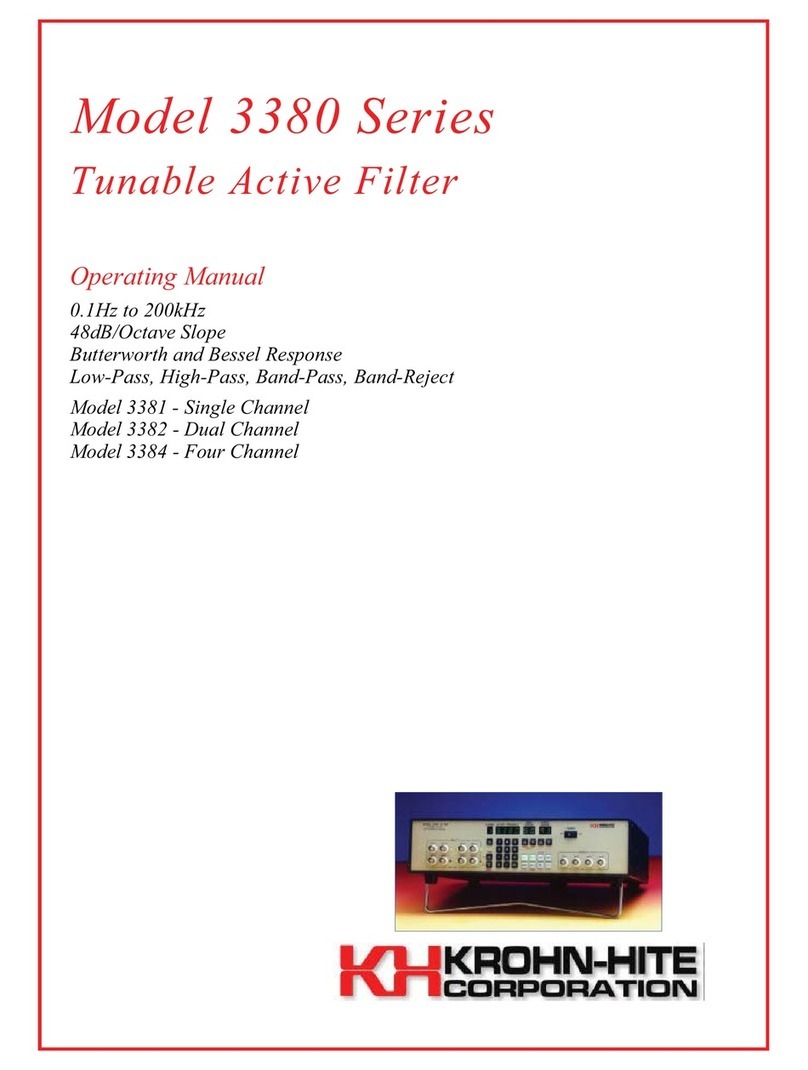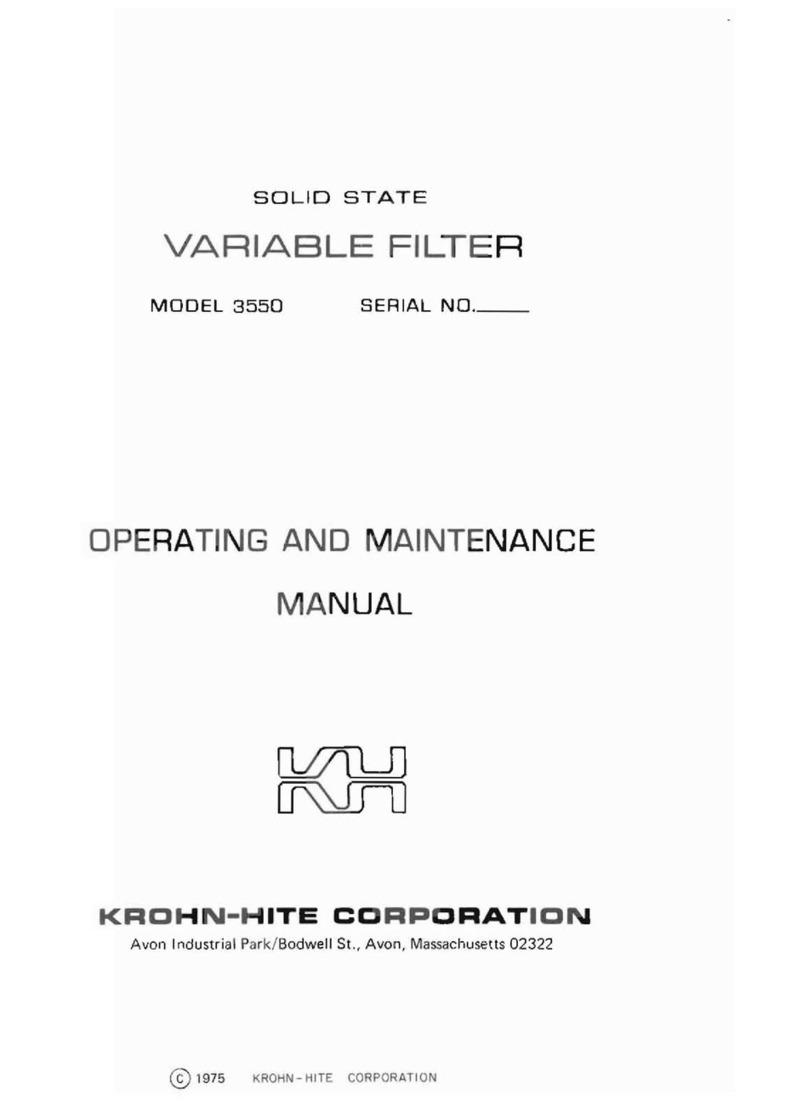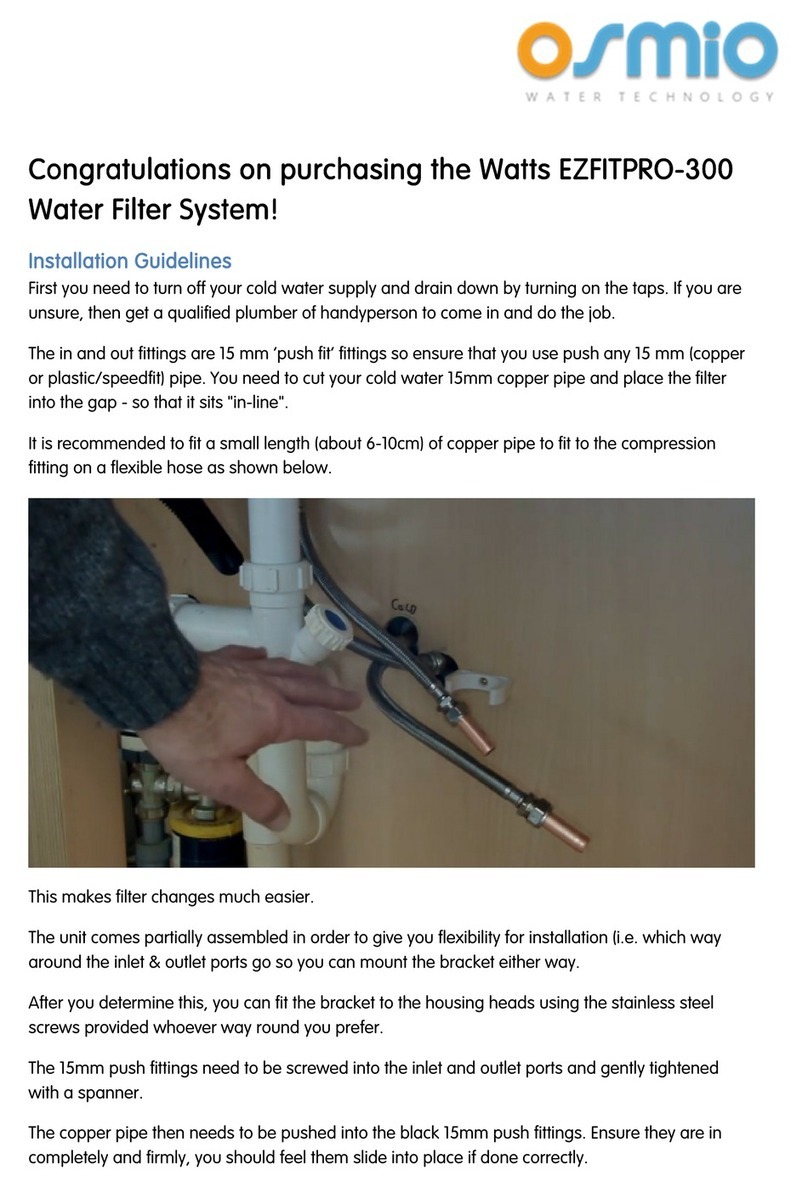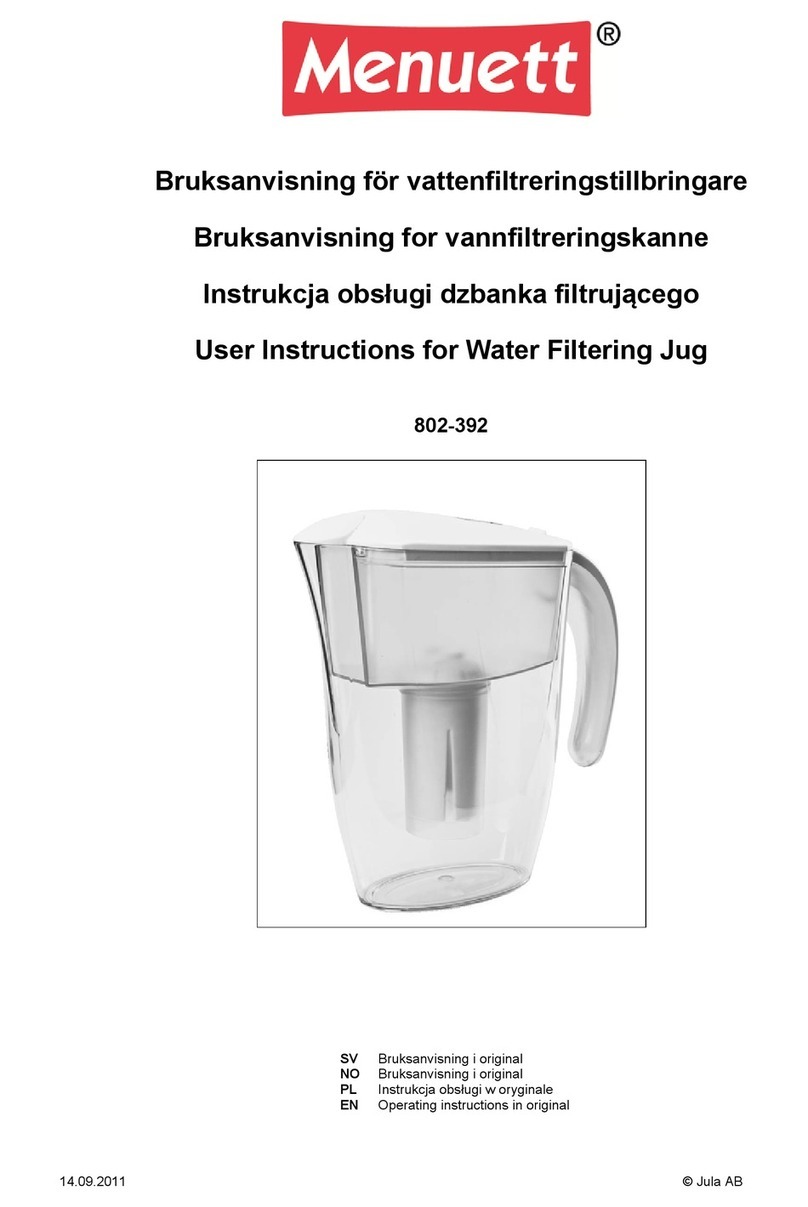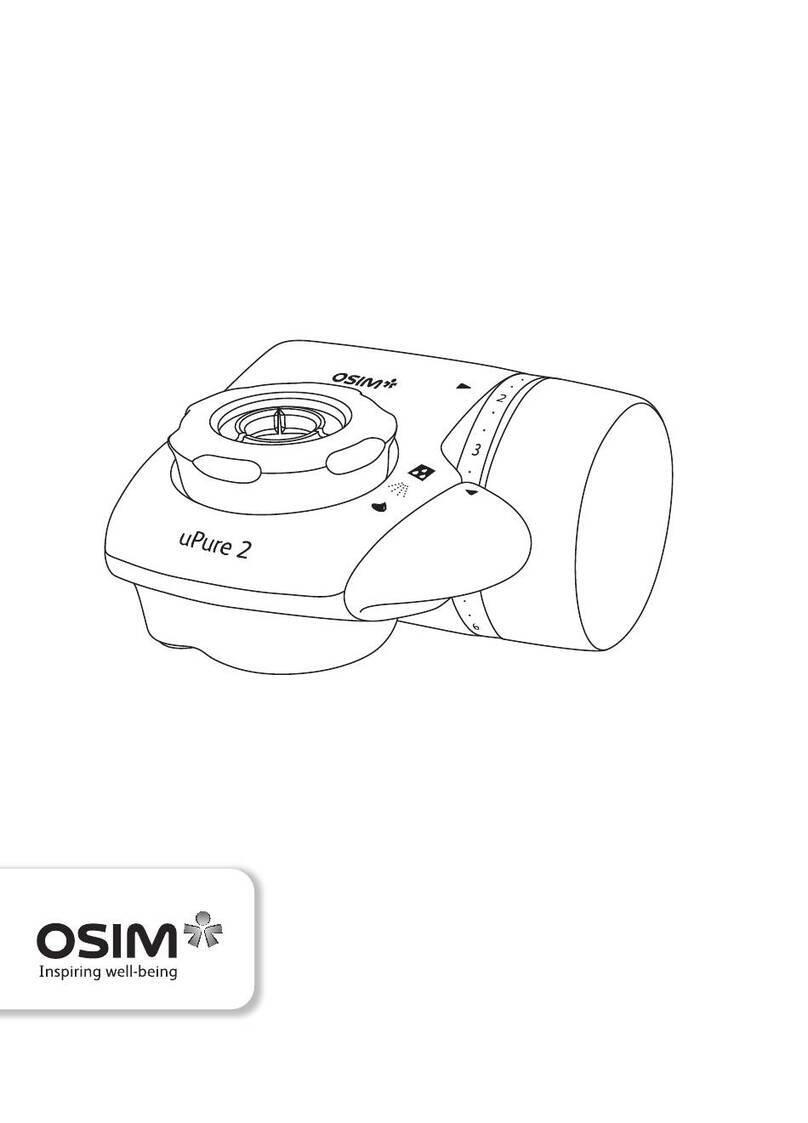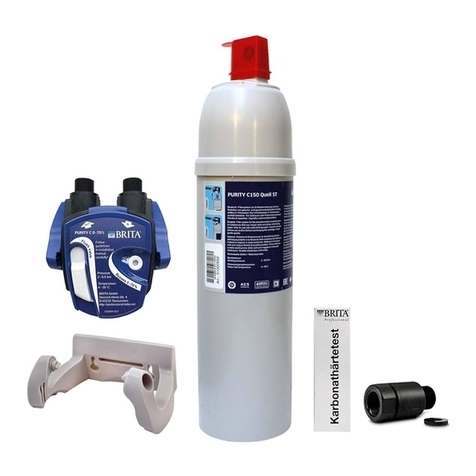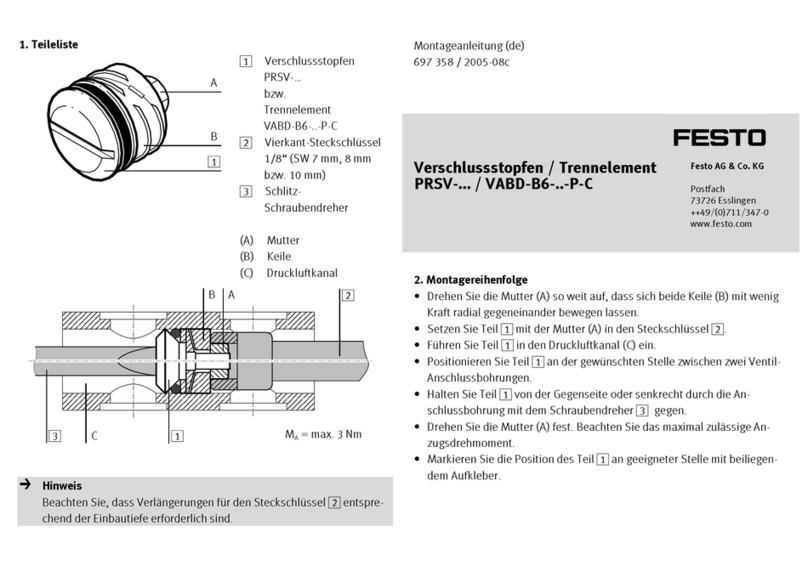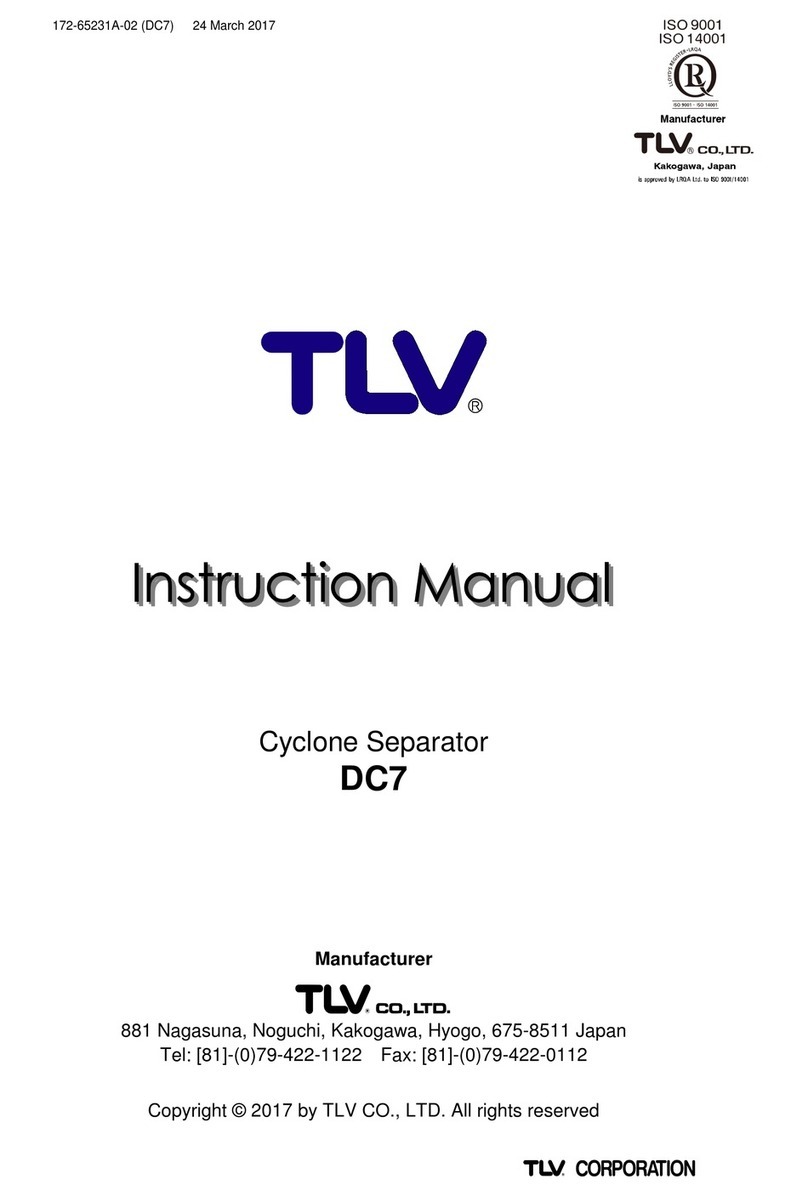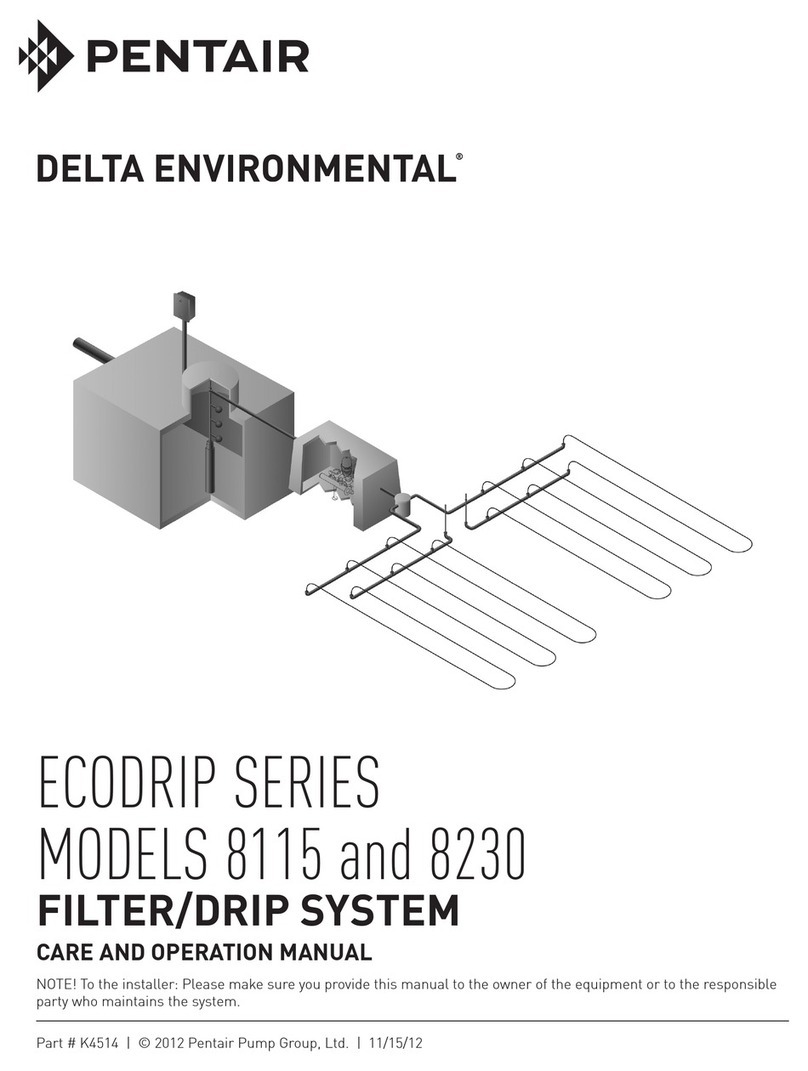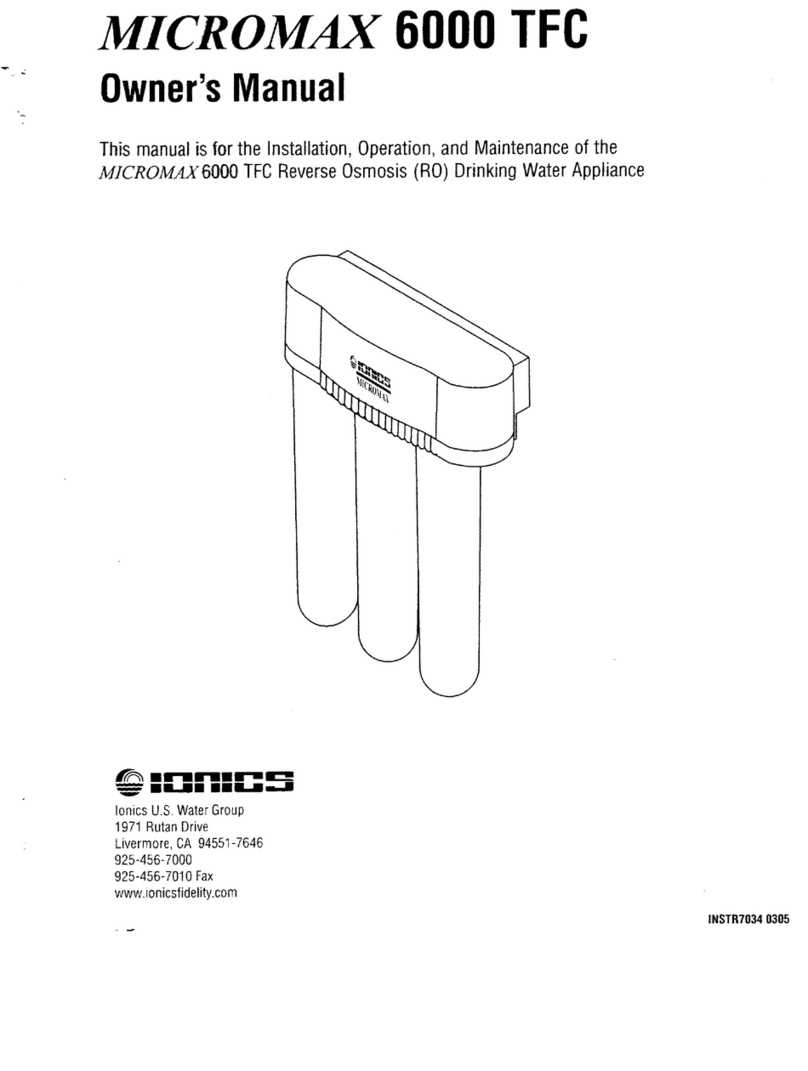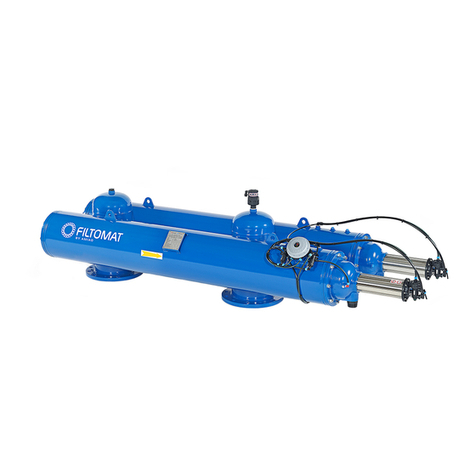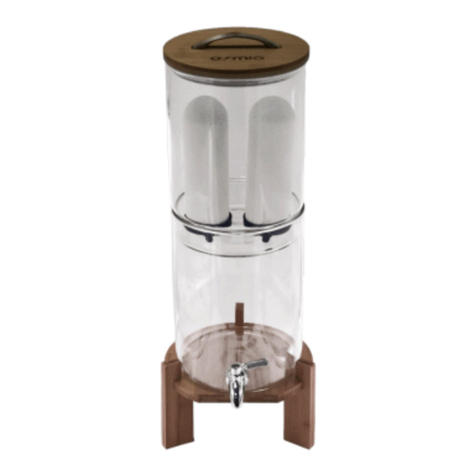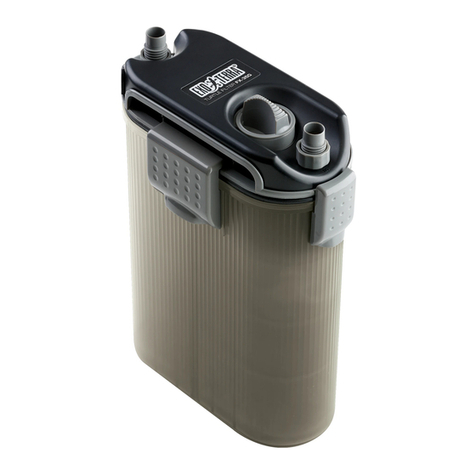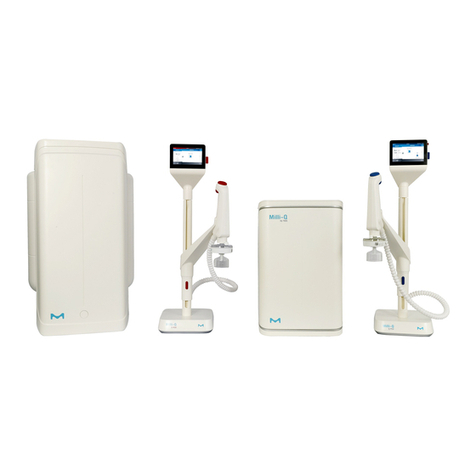Krohn-Hite 3320 Series Operating instructions

DIGITALLY TUNED
VARIABLE FILTER
3320 SERIES
MODEL NO._ SERIAL NO.
OPERATING AND MAINTENANCE
MANUAL
KROHN-H1TE CORPORATION
AVON INDUSTRIAL PARK/SODWELL STREET/AVON, MASS. 02322
1978 KROHN-HITE CORPORATION

Printed in U.S.A., April, 1981

Contents
41.11111111111NONIMMIMMINIMMIIIIMINIMIEMOMMIMIONINIM
IN
I
MMINIMENOMMW
CONTENTS
Section
Page
1
GENERAL DESCRIPTION
/
2
OPERATING INSTRUCTIONS
a
3
CIRCUIT DESCRIPTION
14
4
MAINTENANCE
18
5
CALIBRATION AND ADJUSTMENT
23
ILLUSTRATIONS
Figure
I
—.
Models 3320 and 3323 Filters
._
Page
...ii
. .
2
Multifunction Response CharaEtex;iitiCs
5
2
3
Filter Response to Square Wave Input
5
4
Normalized Attenuation Characteristics
6
5
Normalized Phase Characteristics
7
6
Controls and Connections
9
1
7
8
installation of Batteries
Simplified Schematic Diagram in Low-Pass
12
15
9
Simplified Schematic Diagram in High-Pass
15
10
Typical Quadratic Amplifier Shown in High-Pass
16
11
Schematic, Parts List, and Printed Circuit Layout
Inside
Back
Cover
TABLES
Table
2
Test Points for Low-Pass and High-Pass Operation
Detailed Test Procedure
Page
9
26
t__
L.

Filters, 3320 Series
Model 3320
Model 3323
Figure 1. Models 3320 and 3323 Filters
11

Section 1 - General Description
SECTION I
GENERAL DESCRIPTION
1.1 INTRODUCTION
This manual provides operation and maintenance instructions, with detailed specifi-
cations, schematic diagram and parts list, for the Models 3320, 3321, 3322 and
3323 digitally tuned Filters, illustrated in Figure 1. An optional Rack-Mounting Kit
(Part No. RK-58 for Models 3320/3321; Part No. RK-519 for Models 3322/3323) is
available for installing the Filter into a standard, 19" rack spacing.
Reference
to Operating Instructions, Section 2, is recommended before these Filters
are put into operation, In the event the Filters are not functioning or fail to meet
performance specifications, reference should be made to Maintenance, Section 4.
However, before doing any troubleshooting, it should be determined if the normal
adjustments mentioned in the
Calibration
& Adjustment Procedure, Section 5, will
correct the trouble.
The Models 3320, 3321, 3322 and 3323 Filters illustrated in Figure
1, are
-
variable, electronic Filters with digitally tuned cutoff frequencies. The Models
3320 and 3322 have a cutoff frequency range from 0.001 Hz to 99.9 kHz. The
Models 3321 and 3323
are tunable over the
range from 0.01 Hz to 99.9 kHz. The
pass-band gain is unity (Odb) or 10 (20db), with attenuation rates of 24db per octave
outside the pass-band. Maximum attenuation is greater than 80db and the output
hum and noise is less than 500 microvolts. The Model 3320 (Model 3321) can
function as either a High-Pass or Low-Pass Filter. In the High-Pass mode of opera-
tion the maximum input signal is plus or minus 7 volts peak in the Odb gain position,
plus or minus 0.7 volts peak in the 20db gain position, and the upper 3db point
occurs at approximately 1 MHz. In the Low-Pass mode the Filter is direct-coupled
and the combined ac plus dc input signal should not exceed
+7
volts
peak
in the Odb
gain position and ±0. 7 volts peak in the 20db gain position.
The Model 3322 (Model 3323) consists of two of the Model 3320
(Model
3321)
mounted in a single cabinet isolated from each other, with
independent
power sup-
plies and input and output connectors. When these two filter channels are switched
to the same mode of operation and cascaded, with both channels set to the same
cutoff frequency, the Model 3322 (Model 3323) will function as a High-Pass or Low-
Pass Filter with an attenuation rate of 48db per octave. If the two channels are con-
nected in series, and one channel is operated in the Low-Pass mode and the other
channel in the High-Pass mode, the Model 3322 (Model 3323) will function as a
Band-Pass Filter with an attenuation rate of 24db per octave outside the pass-band.
When the two channels are connected in parallel, as described in Section 2.3, the
Model 3322 (Model 3323) will function as either a Band-Reject Filter with cutoff
frequency limits from 0.001 Hz to
99.9
kHz (0.01 Hz to 99.9 kHz - Model 3323) or
provide a null at any frequency between 0.01 Hz and 1.0 kHz (0.1 Hz and 10 kHz -
Model 3323).
The Filter has a maximally flat (Butterworth) characteristic when the FUNCTION
switch(s) is in the Low-Pass MAX FLAT position. For pulse-type wave-forms this
switch should be in the Low-Pass RC (Low Q) position, optimum for
transient-free
filtering.
1
1

Filters, 3320 Series
1.2 SP ECI FICA TIONS
(Specifications in ( ] apply to Models 332
1
/
3
323).
Frequency Range
Models 3320 and 3322
High-Pass and Low-Pass cutoff frequencies continuously adjustable from 0.001 Hz
to 99.9 kHz in six bands.
BAND
MULTIPLIER
FREQUENCY (Hz)
RESOLUTION
1
0,001
0.001 - 0.999
0.001
2
0.01
1 - 9.99
0.01
3
0.1
10 - 99. 9
0.1
4
1
100 - 999
1
5
10
1, 000 - 9, 990
10
6
100
10, 000 - 99, 900
100
Models 3321 and 3323
High-Pass and Low-Pass cutoff frequencies continuously adjustable from 0.01 Hz
to 99.9 kHz, in 5 bands.
BAND
MULTIPLIER
FREQUENCY (Hz)
RESOLUTION
1
0.01
O. 01 - 9. 99
0.01
2
0. 1
10 - 99. 9
0. 1
3
1
100 - 999
1
4
10
1, 000 - 9, 990
10
5
100
10, 000 - 99, 900
100
Frequency Control (each channel)
Three rotary decade switches for frequency digits and a 6 [ 5] position rotary multi-
plier switch.
Cutoff Frequency Calibration Accuracy
±2% from 0.05 Hz to 9.99 kHz, rising to ±10% at 0.001 Hz [0.01 Hz] (less accurate
in High-Pass mode at 0.001 Hz [0.01 Hz]), 110% from 10.0 kHz to 99.9 kHz (X100
Band). Relative to mid-band level, the filter output is down 3db at cutoff in the
Butterworth (maximally flat) position and approximately 15db down when operated
as a Low-Pass Filter in RC (transient-free) position.
Bandwidth
Low-Pass Mode:
DC to cutoff frequency setting within the range from 0.001 Hz
f 0. 01 Hz] to 99, 9 kHz.
High-Pass Mode:
Cutoff frequency setting within the range of 0.001 [0.01 Hz] and
99.9 kHz to the upper 3db point of approximately 1 MHz.
Band-Pass Operation (Models 3322, 3323):
Variable within the cutoff frequency
limits of 0.001 Hz 0.01 Hz] to 99.
9
kHz. For minimum bandwidth, the High-Pass
and Low-Pass cutoff frequencies are set equal. This produces an insertion loss of
approximately 6db, with the minus 3db points at 0.8 and 1.25 times the midband
frequency.
2

r-
i
Section 1 - General Description
Band-Reject Operation (Models 3322, 3323): Variable within the cutoff frequency
limits
of 0001 Hz [ 0.01
Hz] and
99.9
kHz. The Low-Pass band extends to dc and
the High-Pass band has its upper 3 db point at approximately 1 MHz.
Response Characteristics
Butterworth: Maximally flat, four pole Butterworth response for optimum perform-
ance in frequency
domain.
RC:
Four pole damped response for transient-free time-domain performance.
Attenuation Slope
Nominal 24 db per octave per channel in Low-Pass or High-Pass mode.
Maximum Attenuation
Greater than 80 db for input frequencies to 100 kHz, rising to 60 db at 1 MHz.
Pass-Band Gain (selected by front panel control)
0 ±
0.5 db or 20 0.5 db for bands 2 through 5 [ 1 thru 4], 0 ±
1
db or 20 it 1 db for
bands 1 and 6 [ 5].
Input Characteristics
±7
volts peak in the 0 db gain position, ±0. 7 volts peak in the 20 db gain position to
500 kHz, decrea.siag- to *3 volts peak (±0.3 volts peak in the 20 db gain position) at
1 MHz.
Maximum DC Component Low-Pass Mode: Combined ac plus dc should not exceed
*7 volts peak in the 0 db gain position and ±0. 7 volts peak in the 20 db gain position.
Maximum DC Component High-Pass Mode: ±100 volts.
Impedance: 10 rnegohrns in parallel with 100 pF.
Output Characteristics
Maximum Voltage: *7 volts peak to 500 kHz decreasing to ±3 volts peak at
1 MHz,
open circuit.
Maximum Current: ±70 ma peak to 500 kHz decreasing to 30 ma peak at 1 MHz.
Impedance: 50 ohms.
Distortion: Typically less than 0.1% over most of the range.
Hum and Noise (0 db or 20 db gain position)
Less than 0.5 millivolts rrns for a detector bandwidth of 100 kHz, rising to 2 milli-
volts rrns for a detector bandwidth of 10 MHz. X100 band, High-Pass mode only,
2 millivolts rrns for a detector bandwidth of 100 kHz, rising to 5 millivolts rrns for
a detector bandwidth of 10 MHz.
Output DC Level Stability
±1
millivolt per hour, *1 millivolt per degree C.
Operating Temperature Range
-
10
°
C to 45
°
C.
3

Filters, 3320 Series
Front Panel Controls (each channel)
Frequency Hz:
Three rotary decade switches and a six [five] position multiplier
switch.
DC Levels:
One each screwdriver adjustment control for LP and HP.
Function Switch:
LOW-PASS RC, LOW-PASS MAX FLAT, HIGH-PASS,
Gain Switch: 0 db, 20 db.
Power Switch:
OFF, LINE OPERATE, BATTERY CHARGE/LINE OPERATE,
BATTERY OPERATE.
Floating (ungrounded) Operation
A switch is provided on rear of chassis to disconnect signal ground from chassis.
Terminals
Front panel and rear of chassis, one BNC connector for Input, one for Output, each
channel. One multipurpose connector on rear for chassis ground.
Power Requirements
105-125 or 210-250 volts, single phase, 50-400 Hz, 5 watts for Models 3320 and
3321, 10 watts for Models 3322 and 3323.
Dimensions and Weights
Cabinet Size/
Model Weight Height Width Depth Net Gross
3320/3321
U. S.
5
1
/
4
"
8 5/8"
13 1/2"
12 lbs
14 lbs
Metric
13.3 cm 21.9 cm 34. 3 cm 5. 5 kgs
6.4 kgs
3322/3323
U.
S.
5 1/4"
16 5/8"
13 1/2"
24 lbs
31 lbs
Metric
13. 3 cm 42. 2 cm 34. 3 cm 10. 9 kgs 14.1 kgs
Optional Rack.Mounting Kits
_
iw
RK-58: Models 3320,3321
RK-519: Models 3322, 3323
Optional Battery Kits
Part No. BK-332, Models 3320, 3321; Part No. BK-334, Models 3322, 3323,
1.3 FILTER CHARACTERISTICS
The flexibility of adjustment of bandwidth is shown in Figure 2. Low-pass and High-
Pass operation is shown in curves (1) and (2). The solid lines show the maximally
Flat Butterworth operation while the dotted lines show the RC characteristic.
4

10
100
ix
10K
100K
Hz
3- BAND PASS
SAND REJECT
40
60
10
100
I
OX
00K
0
.01
Hz
.01
db
0
—20
—40
Section 1 - General Description
Curve (3) shows Band-Pass operation for two different bandwidths, illustrated by
curves A and B. Curve B shows the minimum pass-band width obtained by setting
the two cutoff frequencies equal. In this condition the insertion loss is 6 db, and the
-3 db cutoff frequencies occur at 0.8 and 1,25 times the mid-band frequency. Band-
Reject operation for a reject band with a cutoff frequency separation ratio of 10 is
shown by curve 4.
db
- LOW PASS
r
-
4
N
,
i
----
1 ‘
.2 Hz
20 KHz
2 - HIGH PASS
I
.2 Hz
20 KHz
—20
—40
-60
db
0
—20
—40
60
Figure 2. Multifunction Response of Butterworth (solid curves) and Low-Pass
RC (dashed curves).
Response (in Low-Pass Mode) to
1 Hz square wave, with cutoff at
1 kHz. Overshoot is approximately
1 db with FUNCTION switch in LOW-
PASS MAX FLAT position.
Response to same square wave in
LOW-PASS RC (Low Q)
position.
NOTE complete removal of over-
shoot.
Figure 3.
Filter Response to Square Wave Input.
5

The attenuation characteristics
of the Filter are shown in Figure
4. With the FUNCTION switch in
the LOW-PASS MAX FLAT
(Butterworth) mode, the gain as
shown by a solid curve, is virtually
flat until the -3 db cutoff frequency.
At approximately twice the cutoff
frequency the attenuation rate co-
incides with the 24 db per octave
straight line asymptote.
FIL
TER
G
Ai
tl (
LB)
6
-
12
-
18
-24
-30
-36
.2
.3 .4 .5 .6 .8 1
f
fL
— OR —*
fH
f
2
3 4 5 6 8 10
Figure 4. Norrnalize
,
i. Attenuation
Characteristics
Filters, 3320 Series
=NM
1.3.1 Transient Response
The frequency response of this Filter is a fourth-order Butterworth with maximal
flatness, ideal for filtering in the frequency domain. For pulse-type signals, the
FUNCTION switch is set to Low-Pass RC (Low Q) to change the response character-
istic to the R-C type, optimum for transient-free filtering, Figure 3 shows a
comparison of the Filter output response in these modes to a square wave input
signal.
1.3.2 Cutoff Response
0
._
_
Jr
,
_
,---
,
,
.
,
i
,
r
-
I
1
-
4
'
1
i
L
I-
,_
1.-...i_
:
•
,
,
.
--r---
i
1
I
1
I i
it_
hi . HIGH CUTOFF FREQUENCY
\ I
_ •
•
t , . LOW CUTOFF FREQUENCY
1\
7
'
.
I
4
_
24.i...4
-1
\
1
_i_
:
X
•
1
1
-
In the LOW-PASS RC
42
mode, optimum for transient-
.1
free filtering, the dotted line
shows that the gain is down ap-
proximately 15 db at cutoff and
has approximately a 24 dh per oc-
tave attenuation rate at five times
the cutoff frequency. Beyond this
frequency, the Filter attenuation rate and maximum attenuation, in either mode, are
identical.
1.3.3 Phase Response
The phase response of the Model 3320 (Model 3321) or each channel of the Model
3322 (Model 3323) can be obtained from Figure 5 which gives the phase character-
istic for either mode of operation in degrees lead (+) or lag (-) as a function of ratio
of the operating frequency (I) to the low cutoff frequency 11
..
. (HIGH-PASS mode) or
high cutoff frequency fH (LOW-PASS mode).
*
The solid curve is for the MAXI-
MALLY FLAT (Butterworth) mode and the dotted curve is for the transient-free
(LOW-PASS RC mode.
1.3.3.1
Example
Determine the phase shift of the filter in the MAXIMALLY FLAT or Butterworth
mode, with the FUNCTION switch set to the HIGH-PASS mode at the XI position,
the cutoff frequency (IL) set to 100 Hz and an input frequency
(f)
of 300 Hz.
The terms "lead (+)" and "lag (-)" are used only to distinguish between phase
shift in the High Pass mode (lead) vs. phase shift in the Low Pass mode (lag). The
actual phase shift in either mode, of course, will always be lagging, since the out-
put can never occur before the input.
6

No"
A
60
A
0
300
"
Section 1 - General Description
f
300 _
Since TT, .- 100
From Figure 5, 3 = 50
0
The Output of the Filter leads (lags) the Input by 50 (-310) degrees
+360
+300
•
+240
cr)
z
w
°
LAJ
0(5
Ct
Ld
o
W
en
+180
w
a
+120
I
a.
+60
—360
3
4
5 6 8 10
.2
.3
.4 .5 .6
.8
1
2
NORMALIZED FREQUENCY
INPUT FREQUENCY (f)
LOW-CUTOFF
(FL)
OR HIGH-CUTOFF (PH)
Figure 5. Normalized Phase Characteristics
The phase response of the Model 3322 (Model 3323) could be obtained in the same
manner by taking the algebraic sum of the phase response of each channel (Band-
Pass operation, only).
The phase error of the Model 3320 (Model 3321) is related to the setting of the cut-
off frequency and is approximately 2, 5
0
for a 1% frequency error at the cutoff point.
Since the cutoff calibration is *2%, a maximum phase error of 10
0
is possible, al-
though a 2.5
0
phase error is typical.
For some applications the phase difference between channels of the Model 3322
(Model 3323) can be improved by applying the same signal to both channels simul-
taneously
and
tuning one channel to minimize the phase difference. Because the
resolution of phase adjustment is limited to that of the frequency digits, the incre-
ments of phase adjustment near cutoff will vary from 0.25
0
to 2.5
°
when able to use
three digit resolution.

Filters, 3320
Series
SECTION 2
OPERATING INSTRUCTIONS
2.1 INTRODUCTION
On receipt of the Filter, carefully unpack and examine it for damage that may have
occurred in transit. If signs of damage are observed, file a claim with the trans-
portation agency immediately, and notify Krohn-Hite Corporation. Do not attempt
to use the Filter if damage is suspected. Rack-mounting models so equipped mount
with four machine screws in the standard 19-inch rack space. No special brackets
or attachments are needed.
CAUTION
The covers of this instrument should
not be removed when the instrument
is connected to an AC power source,
be‘:;ause of the potentially dangerous
volt.L^..gec.
that exist within the unit.
2.2 FRONT AND REAR PANEL CONTROLS
The front panel of the Model 3320 (Model 3321) and each channel of the Model 3322
(Model 3323) include three rotary decade switches for frequency digits, a six posi-
tion (five position - Models 3321 and 3323) rotary multiplier, a three position func-
tion switch, a two position gain switch, two .BNC coaxial connectors for the INPUT
and OUTPUT signals and screwdrive control adjustments for the output dc level in
the Low-Pass (LP) and High-Pass (HP) functions. A four position POWER switch
selects OFF, LINE, LINE OPERATE/BATTERY CHARGE or BATTERY OPERATE.
See Figure 6.
The tuning network consists of 3 digitally tuned decades and a six [five] position
multiplier. This combination allows setability of over 5, 000 discrete cutoff fre-
quencies, calibration within ±2% (X.01 to X10 bands) and re setability of ()„ 01%.
Each multiplier position covers the frequency range as follows:
BAND
MULTIPLIER
FREQUENCY (Hz)
RESOLUTION
1
0, 001
0. 001 - 0, 999
0.001
2[l]
0,01
1 - 9,99
0.01
3
[2]
0. 1
10 - 99. 9
0. 1
4[3]
1
100 - 999
I
5 [4J
10
I, 000 - 9, 990
10
6 [ 5]
100
10, 000 - 99, 900
TOO
The rear chassis of the Model 3320 (Model 3321) and each channel of the Model 3322
(Model 3323) has a switch for disconnecting the signal ground from chassis ground.
8

UNITS DIGITS
TENS DIGITS
FUSE
1/8 AMP 115v,
1116 AMP 230V
INPUT BNC
CHASSIS GROUND
SIGNAL OR
CHASSIS GROUNDING
HUNDREDS DIGITS
DECADE MULTIPLIER
54IN40 OR 20 DB)
POWER sMTCH OFF
LINE OPERATE
LINE OPERATE/
BATTERY CHARGE
BATTERY OPERATE
16
D
INPUT
IOM OHMS
± 7 VOLTS PEAK (ODB)
t0.7 VOLTS PEAK (20DB)
OUTPUT (BNC)
±7 VOLTS PEAK
±70 MA. PEAK
50 OHMS.
LP D-C LEVEL
CONTROL R601
FUNCTION
LOW-PASS RC
LOW-PASS MAX FLAT
HIGH-PASS
HP 0-C LEVEL
CONTROL R602
NAME PLATE
POWER
OUTPUT BNC
Section 2 - Operating Instructions
Figure
6.
Controls and Connections for Models 3320, 3321, and Each Channel
of Models 3322, 3323
2.3 OPERATION
2.3.1 Model 3320 and Model 3321
a.
Make appropriate power connections as described in Section Z.
6.
b.
Make appropriate connections to the INPUT and OUTPUT connectors of
the Filter. The INPUT voltage should not exceed plus or minus 7 volts peak in the
0 db gain position, or plus or minus 0. 7 volts peak in the 20 db gain position, and
the combined AC and DC INPUT voltage should not exceed 7 volts peak in the Low-
Pass mode.
c.
Set mode of operation and cutoff frequency by means of the band multiplier
switch, the frequency decades and the FUNCTION switch.
9
f

Filters, 3320 Series
d.
Turn power switch to LINE, LINE/BATTERY CHARGE or BATTERY
OPERATE - whichever is applicable.
e.
After sufficient warm-up time check output dc level in the Low-Pass and
High-Pass mode, and if necessary, adjust DC LEVEL potentiometers, R601 and
R602, for zero volts on the output.
NOTE
High-Pass dc level must always be adjusted first.
f.
For normal Filter operation the FLOATING/CHASSIS GROUND switch,
located on the rear of the chassis, should be in the CHASSIS position. If the Filter
is used in a system where ground loops make ungrounded operation essential, this
switch should be in the FLOATING position.
CAUTION
In FLOATING operation, the signal ground
should be connected to system ground to
prevent excessive hum and noise.
g.
When filtering consists principally of separating frequency components of
a signal (frequency domain), the RESPONSE switch should be in the MAX-FLAT
position. If the Filter is used to separate pulse-type signals from noise (time do-
main), this switch should be in the RC position.
2.3.2 Model 3322 and Model 3323
2.3.2.1
To Obtain High-Pass or Low-Pass Operation with 48 db Per Octave
Attenuation, Proceed as Follows:
a.
Cascade the two channels by connecting the output of the left channel to
the input of the right channel.
b.
Select identical mode of operation and multiplier position for both channels.
c.
Set frequency digits of both channels to the same cutoff frequency.
NOTE
When the two channels are cascaded and set to the same mode
of operation with identical cutoff frequencies, the gain at the
cutoff frequency will be down 6 db from the pass-band gain
with the two RESPONSE switches in the MAX-FLAT (Butter-
worth) position. In the Low-Pass RC position the gain at cutoff
frequency will be down approximately 30 db.
d.
In the Model 3322 (Model 3323) if the gain switch of each channel is set to
20 db the resultant overall gain is 40 db. Under these conditions the output of the
first channel cannot exceed *0. 7 volts peak or it will overload the input to the sec-
ond channel. This limits the input signal of the first channel to *0.07 volts peak.
When one channel is operated with 20 db gain, the signal to noise ratio improves by
20 db. However, the signal to noise ratio, when both channels are in cascade, does
not improve by 40 db because the noise of the first channel is amplified by the sec-
ond channel.
10

Section 2 - Operating Instructions
2.3.2.2
To Obtain Band-Pass Operation with 24 db per Octave Attenuation,
Proceed as Follows:
a.
Cascade the two channels,
b.
Set the left channel to the High-Pass Mode (this will control the Low-
Cutoff frequency). Set the right channel to the Low-Pass mode (this will control
the High-Cutoff frequency).
Band-Pass operation could also be obtained by setting the left channel to the Low-
Pass mode and the right channel to the High-Pass mode. The first method has the
advantage that the Low-Cutoff Frequency (High-Pass mode) is on the left and the
High-Cutoff Frequency (Low-Pass mode) is on the right, which is the logical ar-
rangement since it coincides with our customary graphical representation of a
Band-Pass Filter. This may be disadvantageous, since the output is dc-coupled,
because the Low-Pass channel is on the right. If the second method is used, the
output amplifier is ac-coupled, which is desirable in some applications where only
minimum dc fluctuations on the output can be tolerated.
c.
The minimum Pass-Band is obtained by setting the High-Cutoff Frequency
equal to the Low-Cutoff Frequency. In this condition the insertion loss is nominally
6 db and the -3 db cutoff frequencies occur at 0.8 and 1.25 times the mid-band fre-
quency. See curve 3B in Figure 2.
2.3.2.3
To Obtain Band-Reject or Notch Filter Operation, Proceed as Follows:
a.
Connect the two channels in parallel by connecting the input signal to the
BNC INPUT connector of both channels simultaneously.- The OUTPUT from both
channels should be added through two equal external resistors in series with each
.
•
output.
*
The junction of these resistors becomes the output of the Filter. It is
recommended that the resistors be approximately 50 ohms and of the carbon or
metal film type if the Filter is used at high frequencies. If the two resistors are
not equal, the gain on one side of the notch will be different than the gain of the
other.
b.
The first channel should be set for Low-Pass operation.
c.
The second channel should be set for High-Pass operation.
d.
It should be noted that the output impedance in the Band-Reject mode will
not be 50 ohms, but approximately 25 ohms plus one half the resistance of one
adding resistor. The maximum input should not exceed 5 (0.5 in 20 db gain posi-
tion) volts rrns and the maximum output voltage in this mode will be 2. 5 volts =is
open circuit.
e.
Because the resolution is limited to one part in 3 decades, the sharpness
of null will vary, depending on frequency. Although a typical null is 60db, a null
greater than 80 db is possible due to phase cancellation.
2.4 HUM AND NOISE
The hum and noise of the Filter is composed of white noise and line frequency har-
monics. The actual noise observed at the output will depend on the Filter setting.
Narrower pass-band will produce less noise, as will a setting that rejects line
frequency and harmonics.
An optional Band Reject Kit (Part No. BK-30) is available, and consists of matched
cables and connectors to adapt the filter channels for parallel operation.
11

/".
91101
/
91 102
T8301
*
TOP VIEW
BOTTOM VIEW
Filters, 3320 Series
2.5 TERMINALS
BNC coaxial connectors are provided on the front panel and on the rear of the
chassis for both INPUT and OUTPUT connections.
2.6 POWER REQUIREMENTS
2.6.1 Line Operation
The Filter, unless otherwise specified, is wired for operation from an ac power
source
01
105-125 volts, 50 to 400 Hz.
The Model 3320 (Model 3321) and each channel of the Model 3322 (Model 3323) uses
a
1
/
8
ampere slow blow line fuse mounted on the rear of the chassis. This may be
modified to operate from a 210-250 volt line by removing the two jumpers connect-
ing terminals 1 to 3, and 2 to 4 of the power transformer(s), and adding a jumper
between terminals 2 and 3 of the power transformer(s). In the Model 3322 (Model
3323) there are two power transformers and both should be modified when the line
voltage is changed. For 210-250 volt operation a 1/16 ampere
slow blow fuse
should
be used for the Model 3320 (Model 3321) and each channel of the Model 3322 (Model
3323).
2.6.2 Optional Battery Kit
If
specified, the Filter will be supplied with batteries 'installed. To operate the
Filter using battery power, it is only necessary to
et the power switch
tn BATTERY
OPERATE. Batteries may be added to any instrument, at any time. For Models
3320, 3321 order Part No. BK-332; for Models 3322, 3323 order Part No. BK-334,
2.7 INSTALLATION OF BATTERIES
To install batteries remove the
side, top and bottom covers. At
the rear of the chassis, two
clamps and two brackets are pro-
vided to hold the two batteries.
See Figure 7. The batteries
should be 12 volt Union-Carbide
type Y5403.
Place one battery (3T102-Fig-
ure 7), with the negative pole
facing the bottom of the chassis,
and the other (BT101) with the
Figure 7. Installation of Batteries
positive facing the bottom. Con-
nect a wire from the plus terminal
of TB301 to the positive pole of Battery BT101 and a wire from the negative terminal
of TB301 to the negative pole of battery BT102. Turn chassis over and connect the
two remaining poles of the batteries together. Connect a lead from this point thru
the small grommet (see Figure 7) to the ground terminal on TB301.
The batteries used in the 3320 Series are of the nickel cadmium type. These
batteries may be recharged many times without loss of performance, and are
designed to operate continuously for 10 hours without recharging.
12

Section 2 - Operating Instructions
Due to the type of battery
used
in the 3320 Series,
it
is difficult to determine the
state of charge on the batteries. If the open circuit voltage of the battery is greater
than 13 volts, it is more than likely that the battery is sufficiently charged for 10
hours operation. If voltage is less than 13 volts, it is recommended that the battery
be charged for approximately 14 hours. If the battery will not operate for 10 hours
after charging for approximately 14 hours, it should be replaced. The internal
charging circuit of the filter is designed to recharge the batteries to full capacity in
12 to 16 hours. For optimum battery performance prolonged periods of continuous
charging (greater than 16 hours) should be avoided.
-
13

Filters, 3320 Series
SECTION 3
CIRCUIT DESCRIPTION
3.1 INTRODUCTION
As shown in the Simplified Schematic Diagrams, Figures 8 and
9,
the Model 3320
(Model 3321) and each channel of the Model 3322 (Model 3323) is a four-pole,
variable, electronic filter that can be operated as either a Low-Pass or a High-
Pass Filter. It has a variable cutoff frequency adjustable between 0.001 Hz and
99.9 kHz (0.01 Hz and 99.9 kHz - Models 3321 and 3323) by means of three frequency
decade switches and a six-position (five position - Models 3321 and 3323) multiplier
switch. In the Low-Pass mode, it is direct-coupled and, in the High-Pass mode,
its upper 3 db point is approximately 1 MHz. A response switch selects either
Butterworth (maximally flat response) or a RC frequency characteristic, which
improves the transient response by eliminating overshoot when pulsed input signals
are applied.
The Schematic Diagram of the Model 3320, (Model 3321), Figure 11, is at the rear
of this manual. Bold lines on the Schematic Diagram show the main signal paths,
while the cla.elled iites indicate feedback signal paths. As shown in Figures 8 and 9',
the Model 3320 (Model 3321) consists of four RC tuning elements coupled by Network
Amplifiers. The cutoff frequency is tuned capacitively in decade steps by the band
switch, and digitally within each decade by the frequency decade switches. The
same capacitors and resistors are used in both the High-Pass and the Low-Pass
mode.
The Model 3320 (Model 3321) Filter consists of a pair of two-pole R-C sections -
"Quadratics" - coupled together by two Network amplifiers. rnach Quadratic is
adjusted to give a Butterworth response when both are cascaded. The response of
the first Quadratic falls off smoothly with no peak as the frequency approaches the
cutoff frequency, and the gain at cutoff is -5.3 db. The response of the second
Quadratic is peaked approximately 2.3 db at the cutoff frequency and when both
Quadratics are cascaded, the resultant response is flat with no peak and a sharp
fallorf as it goes through cutoff.
3.2 DETAILED DESCRIPTION
3.2.1
Input Amplifier
The Input Amplifier is a two stage operational amplifier consisting of dual FET
4130, and transistors Q133, and Q134. Q130 forms a balanced stage with the
input signal applied to the gate of Q130A and the gate of 0130B at zero signal level.
Resistors R132, R136, R137 and R138, broadbanded by capacitors C131, C132,
C135 and C136 form the gain determining feedback network in the "20 db" position
of the "GAIN" switch. In the "0 db" position RI36 and C132 are shorted and the
gain is determined by R131, R138, C131, C135, C136. R137 is ineffective because
it is just loading the summing point of an operational amplifier.
14

,N PUT
0160
0166
01
INPUT
AMPLIFIER
3
(Th
0130
10134
OUTPUT
AMPLIFIER
On
OUTPUT
011
01
INPUT
AMPLIFIER
OUTPUT
AMPLIFIER
NOTES
1.
NUMBERS SHOWN IN CIRCLES REFER
TO PIN NUMBERS ON PC CARO.
2.
DASHED SIGNAL LINES iNDicATE
FEEDBACK PATHS.
Section 3 - Circuit Description
NOTES
L
_ _ _
I. NUMBERS SHOWN IN CIRCLES REFER
TO PIN NUMBERS ON PC CARD.
2.0ASHED SIGNAL LINES INOICATE
FEEDBACK PATHS.
RC
I M
AX FLAT
Figure 8. Simplified Schematic Diagram in Low-Pass
Figure 9. Simplified Schematic Diagram in High
-
Pass
The input signal in the LOW-PASS mode is direct coupled and is applied thru R132
to the gate of 0130A. R132, in addition to determining the gain of the amplifier,
acts as current limiting to prevent damage to the Filter in the event of excessive
input signal. In the HIGH-PASS mode the input is capacitor coupled by C271 and
C273 (and C272 in Models 3320 and 3322 only) which allows input signals with a
D-C component of plus or minus 100 volts to be applied to the input without over-
load.
The output stage, Q133 and Q134, develops the low impedance output to drive the
first R-C network. Diodes CR131 and CRI32 cancel thermal drift in Q133 and
Q134.
3.2.2 Network Amplifier
The operation of all Network Amplifiers is nearly identical, and only the first
Network Amplifier - Q160 to Q166
-
will be presented in detail. The first Ampli-
fier consists of a balanced input stage - Q160 and a balanced output stage - Q164,
Q165 which develops the drive signal for the following section of the R-C tuning
network. The input signal from the preceding network is applied to the gate of
0160B with local feedback going to the gate of 0160A. For maximum signal swing,
transistors Q163 and Q166 maintain constant current in the input and output stages.
At low frequencies, trim resistor R161 (R221 in second Quadratic) is adjusted for
15

Filters, 3320 Series
11116.
111111111111.1ft
optimum cutoff calibration. This trim is modified on the two highest bands, X10
and X100, by trim resistors R272 (R284) and R273 (R285) in the Low-Pass mode
and R274 (R286) and R275 (R287) in the High-Pass mode. Trim capacitors C164
and C166 (C223, C224 in second Quadratic) are adjusted to neutralize the effect of
capacitance loading on the input of the amplifier - gate of Q160B (Q220B second
Quadratic).
3.2.3 R.0 Tuning
Network
Models 3320, 3321 (and each channel of Models 3322., 3323) is a 4-pole filter, con-
sisting of 2 2-pole sections or "Quadratics" (so called because the transfer func-
tion of each is a 2nd order or quadratic function). Each quadratic has 2 cascaded
RC tuning elements and an amplifier that acts as buffer between stages and also
provides the gain necessary in an active filter.
The desired frequency charac-
teristic of each Quadratic is
effected by feeding back the suitably
amplified output signal to the first
o s
o
R-C network. The gain of each
amplifier is adjusted for the proper
response of each quadratic, so
that cascaded they produce a
Butterworth characteristic. The
resistive component of the tuning
network consists of three rotary
switches, calibrated from 0 to 9 in
hundreds, tens, and unit steps.
These switches select the proper resistor in each of the R-C networks. The capaci-
tive element of the tuning network is selected by the rotary multiplier, calibrated in
decades from X.001 to X100 (X.01 to X100 - Models 3321, 3323).
3.2.4 Output
Amplifier
The output Amplifier is a four stage operational amplifier consisting of dual FET
Q240 and transistors Q243 thru Q248. FET Q240 form a balanced stage with the
input signal applied to the gate of Q240A and the second input of the amplifier (gate of
Q240B) at zero signal level. The output of this stage is connected to the differentially
connected transistors Q243 and Q244 which drive the next stage, Q245 and Q246.
Transistors Q247 and Q248 form a complementary emitter follower and produce the
high current, low impedance output of the filter. Q246, Q247 and Q248 of the output
amplifier are connected to the plus and minus 15.5 volt unregulated supply which en-
ables an output signal swing of plus or minus 7 volts peak and a maximum current
of plus or minus 70 ma. At low frequencies, the gain of the amplifier is determined
by resistors R265, R256, R241, R244 and trim R257, broadban.ded by capacitors
C241, C242, and C247.
In the High-Pass mode
this divider is modified on the two
highest bands,
X10 and X100, by R288 and R290 and capacitors C324, X10 band,
and C325 on
the
X100 band.
In the
Low-Pass mode the gain of the amplifier is
modified on the X10 and X100 bands by R291 and R292 respectively.
16
_
Figure
10. Typical Quadric Amplifier
Shown in High-Pass
Table of contents
Other Krohn-Hite Water Filtration System manuals
Popular Water Filtration System manuals by other brands
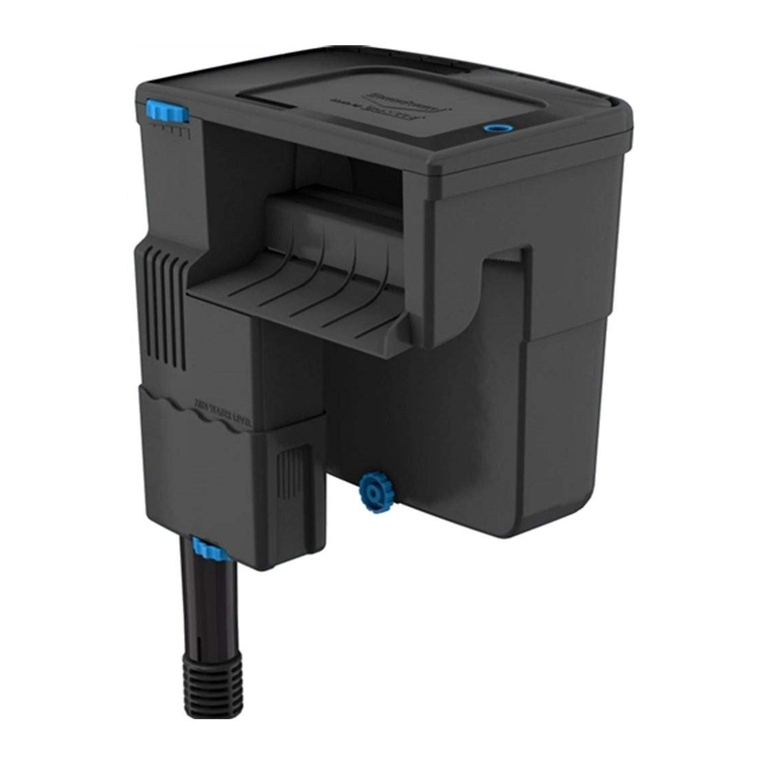
Sicce
Sicce Seachem Tidal 35 owner's manual

ELECTROSEA
ELECTROSEA ElectroStrainer ES-200 installation manual

Ecosoft
Ecosoft Dewberry Instructions for use
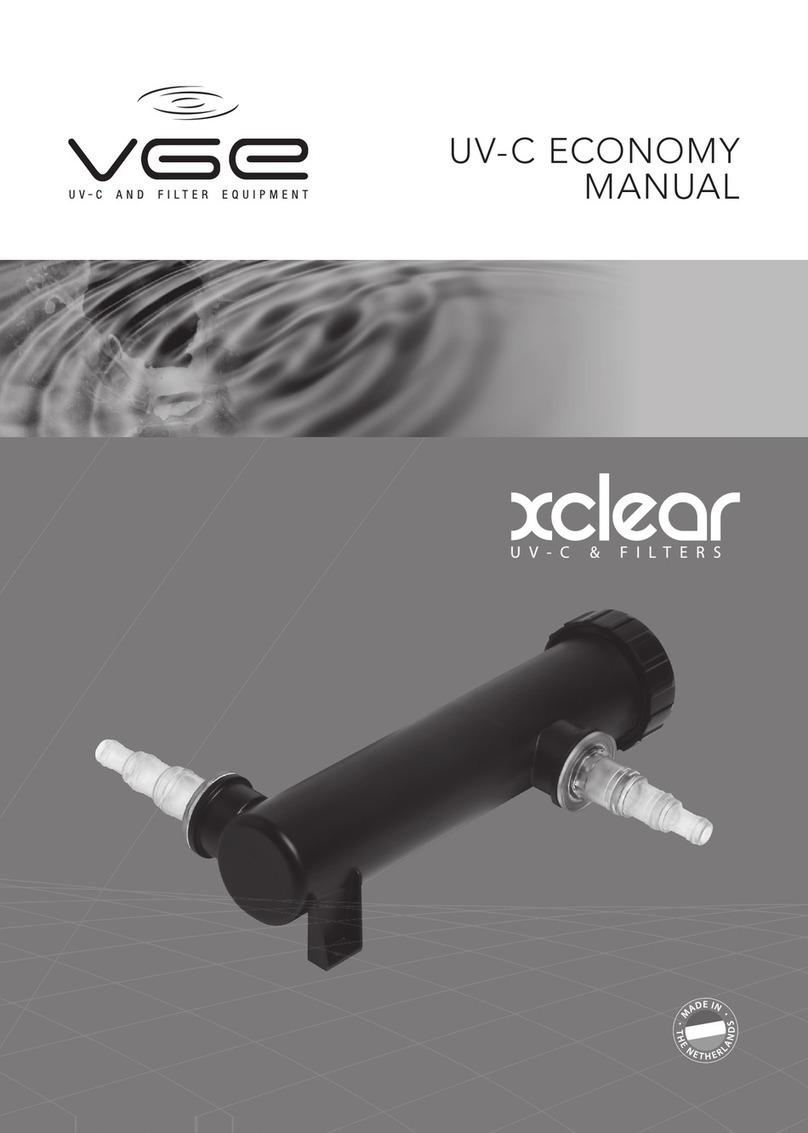
VGE
VGE XCLEAR user manual
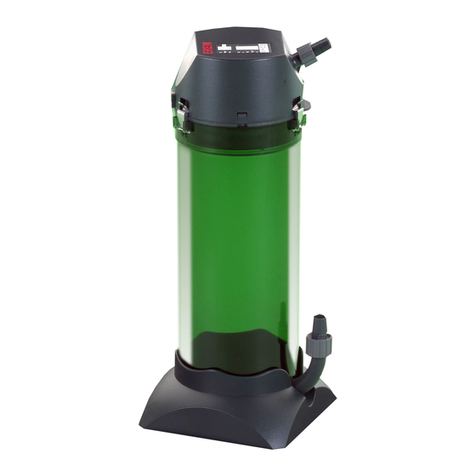
EHEIM classic
EHEIM classic 2211 manual

Premier
Premier Whole House Filtration 500221 Installation, operation and maintenance manual

